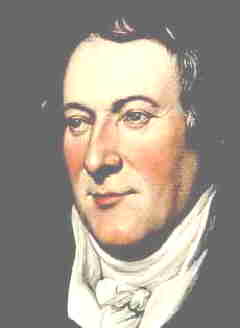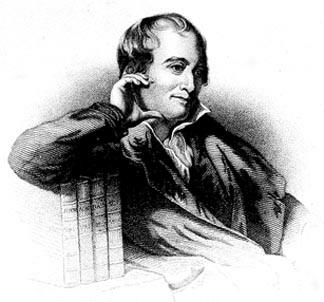In 1803 Maclure served in Paris on a United States Commission representing American citizens with losses resulting from the French Revolution. In Switzerland in 1805, he visited the educational leader Johann Heinrich Pestalozzi, and in 1806 he contracted the Pestalozzian educator Joseph Neef. Having conducted geological studies in France and Spain, Maclure began intensive studies in the United States in 1808.
In 1812, while in France, Maclure became a member of the newly founded Academy of Natural Sciences of Philadelphia (ANSP). In 1815, Maclure contracted Charles-Alexandre Lesueur, artist and natural scientist, and the two traveled extensively together, arriving in Philadelphia in 1816. Joined by Thomas Say and Gerhard Troost, the four made a geological trip in eastern states in 1817. That same year, Maclure became president of the ANSP, a post he held for the next twenty-two years.
The next few years, Maclure traveled and resided in France, Italy, Paris, Switzerland, and Spain. In 1824, he visited Robert Owen's cotton mill at New Lanark, Scotland. In July, 1825, he arrived in Philadelphia with Madame Fretageot's nephews. The following November, he met Robert Owen in Philadelphia and decided to join Owen's venture to Harmonie, recently purchased by Owen from the Harmonist leader, George Rapp.
In January, 1826, the keelboat, Philanthropist, afterwards known as "The Boatload of Knowledge," journeyed down the Ohio River to Mount Vernon, Indiana. From there the travelers made their way to New Harmony. Among them were Lesueur, Say, Maclure, and Pestalozzian educators Marie Duclos Fretageot and William S. Phiquepal. Soon to join them in New Harmony were Neef and Troost.
|
 |
| William Maclure, oil portrait by Charles Wilson Peale. Used by permission of Ewell Sale Stewart Library, The Academy of Natural Sciences of Philadelphia.
|
|
After 1826, Maclure spent most of his time in Mexico. However, he continued financial support through Madame Fratageot's management in New Harmony, enabling the scientific work of Thomas Say and Charles-Alexandre Lesueur and later, David Dale Owen and other geologists.
Much has been written about the coming together of Maclure and Owen, as well as their separation of ways. According to W. H. G. Armytage, in "William Maclure, 1763-1840: A British Interpretation," (Indiana Magazine of History 47 (1951) 1-20),
"Owen was anxious to inaugurate his new moral world as far away from the corrosions of the old one as possible; Maclure wished to try the Pestalozzian methods of instruction on human beings who had known no other. It was but natural that they should get together, especially as Maclure's considerable wealth enabled him to play the part of joint patron. The agreement was that each should provide the sum of one hundred fifty thousand dollars: an agreement which was to be the ostensible cause of their parting."
For a full-length biography, see
Leonard Warren, Maclure of New Harmony: Scientist, Progressive Educator, Radical Philanthropist, Indiana University Press, 2009.
Twenty geological publications by William Maclure are listed in
John M. Nickles, Geologic Literature on North America 1785-1918, Part I. Bibliography, U.S.G.S., Government Printing Office, Washington, 1923.
Among these publications are "Observations on the geology of the West India Islands, from Barbados to Santa Cruz, inclusive" and "Essay on the formation of rocks, or an inquiry into the probable origin of their present form and structure," appearing initially in Journal of the Academy of Natural Sciences of Philadelphia in 1817 and 1818 and then as reprintings from the press in New Harmony in 1832. Most of Maclure's other publications appeared in American Journal of Science and Arts, founded by his colleague Benjamin Silliman, Professor of Chemistry at Yale, in 1818. The next year, Silliman organized the American Geological Society, and Maclure was elected president.
The European Journals of William Maclure, edited, with Notes and Introduction by John S. Doskey, was published in 1988 by the American Philosophical Society.
The June 1998 issue of the Indiana Magazine of History is devoted to Maclure, his times, and his influence. The titles of the articles and authors are as follows:
In Search of the Real Maclure, Josephine Mirabella Elliott and Donald E. Pitzer, 84-88.
"The Spirit Of Improvement": The America of William Maclure and Robert Owen, David Feller, 89-98.
The Spain William Maclure Knew, Alberta Gil Novales, 99-109.
William Maclure's Boatload of Knowledge: Science and Education into the Midwest, Donald E. Pitzer, 110-137.
The Boatload of Trouble: William Maclure and Robert Owen Revisited, Charles Burgess, 138-150.
The Parallel Impacts of William Maclure and Amos Eaton on American Geology, Education, and Public Service, Markes E. Johnson, 151-166.
William Maclure as Publisher in the New Harmony Reform Tradition, Ian MacPhail and Marjorie Sutton, 167-177.
William Maclure: Patron Saint of Indiana Libraries, Josephine Mirabella Elliott, 178-190.
New Harmony Scientists, Educators, Writers & Artists
Chonetes maclurea Norwood and Pratten
Maclura pomifera (Rafinesque) Nuttall
Maclurites magnus Lesquereux
New Harmony Workingmen's Institute, legacy of William Maclure
Academy of Natural Sciences of Drexel University (formerly of Philadelphia)
Clark Kimberling Home Page

